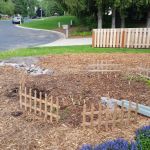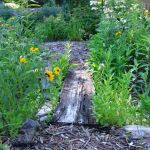Neighborhood Spotlight: Schmidt Family
VADNAIS HEIGHTS— The Schmidt’s ¾ acre native oasis started as a humble butterfly garden in a corner of their backyard pond. Inspiration for a new landscaping plan came from a combination of factors. In 2014, their front yard aspen trees died off, which signaled a need for something new in their place. Since the Schmidt’s were adding gutters to their home around the same time, they saw an opportunity to install a raingarden at the end of the downspout. The Schmidt’s learned about VLAWMO’s cost-share program through a grant VLAWMO gave to the White Bear Montessori for raingardens and native plantings on the school grounds. From their connection to the school, they saw up-close how the raingardens were built, how they worked, and how they were maintained. Taking this experience to their own property, what followed was a smaller-scale adaptation with their own personalized touch.
Their project has now grown into two raingardens, a dry creek, and upland prairie plants covering most of their front yard. Gina Schmidt acknowledges that “it’s not maintenance-free gardening by any means, but it has become family gardening with a purpose.” Both she and her husband Michael have been surprised by the diversity of songbirds and insects they’ve seen. “The beauty and nature our gardens provide us every day is inspiring and well worth the effort.”
Garden Chat with Gina Schmidt:
What do you enjoy most about the raingarden and native planting? What inspired you to pursue it? We are big nature lovers and wanted to be the best stewards of our land as possible. Helping pollinators in peril seemed like the right thing to do when we were updating our landscaping. We were involved with the raingarden projects at White Bear Montessori school and decided to take advantage of the generous cost-share grant opportunity that VLAWMO offers to homeowners.
How has it changed your interaction with your yard? Never did we imagine the impact our gardens would have on wildlife. Our native plants are magnets for a stunning array of song birds, butterflies, bees and other insects. We will stop and observe who’s visiting our garden right from our bedroom windows at different times of the day. Morning coffee is delightful while sitting on the bench in the front garden. Also, we have been amazed by the fire flies in the tall, backyard grasses in June the past few years. They are so fun to watch.
What’s the most challenging part of the raingarden? With the native planting? Due to our heavy clay soil and sloping front yard, we needed to expand our original design for the runoff water to infiltrate. It was a wide, shallow raingarden that had overflow into the street. To capture this overflow, we added a second raingarden (what’s known as a “treatment train”) and connected the two with a dry creek bed.
The most challenging part of our front yard garden is weeding in the spring. It is essential to stay on top of it. Thankfully, our whole family pitches in. Distinguishing between plants and weeds can be difficult, until you get to know them. Also, natives don’t stay put and will self-seed. Learning these plant characteristics comes from observing their growth patterns each year. Even so, I’d rather spend time in my blooming garden than mowing grass any day!
What has surprised you as you’ve maintained the project and watched it grow? It’s a great feeling to know we are part of a growing movement to increase habitat for our native creatures. As more people choose to add pollinator-friendly landscapes, the more we can connect our native patches to help them survive. Clean water is also something which we are impacting here in our watershed. All the while, we are continuously enjoying our beautiful landscape throughout the four seasons.
What would you do differently if you created another garden or started over? Any advice for folks interested in a similar project but not sure where to start? Start small and observe the difference native plants will make in your landscape verse the cultivars. You will fall in love with their beauty, resilience and their wildlife attraction. It is also helpful to make a mind-shift to embrace the unkept beauty of native plants. Understanding their mature height and space requirements before you install will help you become a happy planter! VLAWMO’s expert staff was so helpful and supportive throughout the process, from application to installation. It helps to consult with them and other landscape professionals for selecting appropriate plants and reviewing quotes upfront.
###
Learn more about our cost-share program on our grants page.












